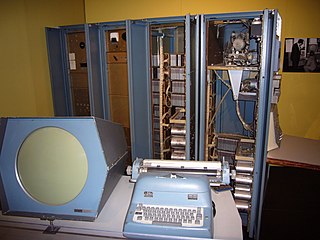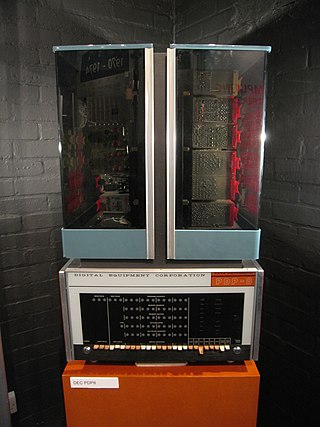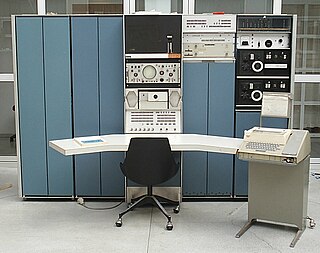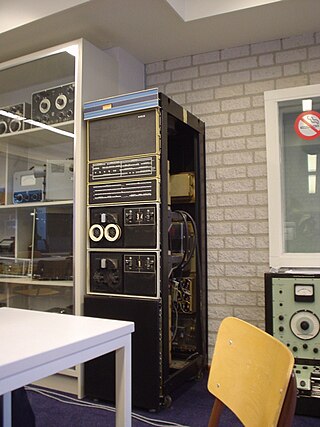Related Research Articles

Digital Equipment Corporation, using the trademark Digital, was a major American company in the computer industry from the 1960s to the 1990s. The company was co-founded by Ken Olsen and Harlan Anderson in 1957. Olsen was president until he was forced to resign in 1992, after the company had gone into precipitous decline.

Digital Equipment Corporation (DEC)'s PDP-10, later marketed as the DECsystem-10, is a mainframe computer family manufactured beginning in 1966 and discontinued in 1983. 1970s models and beyond were marketed under the DECsystem-10 name, especially as the TOPS-10 operating system became widely used.

Programmed Data Processor (PDP), referred to by some customers, media and authors as "Programmable Data Processor," is a term used by the Digital Equipment Corporation from 1957 to 1990 for several lines of minicomputers.

The PDP-1 is the first computer in Digital Equipment Corporation's PDP series and was first produced in 1959. It is famous for being the computer that was most important in the creation of hacker culture at Massachusetts Institute of Technology, BBN and elsewhere. The PDP-1 is the original hardware for playing history's first game on a minicomputer, Steve Russell's Spacewar!

The PDP-8 is a family of 12-bit minicomputers that was produced by Digital Equipment Corporation (DEC). It was the first commercially successful minicomputer, with over 50,000 units being sold over the model's lifetime. Its basic design follows the pioneering LINC but has a smaller instruction set, which is an expanded version of the PDP-5 instruction set. Similar machines from DEC are the PDP-12 which is a modernized version of the PDP-8 and LINC concepts, and the PDP-14 industrial controller system.

The PDP–11 is a series of 16-bit minicomputers sold by Digital Equipment Corporation (DEC) from 1970 into the late 1990s, one of a set of products in the Programmed Data Processor (PDP) series. In total, around 600,000 PDP-11s of all models were sold, making it one of DEC's most successful product lines. The PDP-11 is considered by some experts to be the most popular minicomputer.

The PDP-7 was an 18-bit minicomputer produced by Digital Equipment Corporation as part of the PDP series. Introduced in 1964, shipped since 1965, it was the first to use their Flip-Chip technology. With a cost of US$72,000, it was cheap but powerful by the standards of the time. The PDP-7 is the third of Digital's 18-bit machines, with essentially the same instruction set architecture as the PDP-4 and the PDP-9.

RSX-11 is a discontinued family of multi-user real-time operating systems for PDP-11 computers created by Digital Equipment Corporation. In widespread use through the late 1970s and early 1980s, RSX-11 was influential in the development of later operating systems such as VMS and Windows NT.

The PDP-6, short for Programmed Data Processor model 6, is a computer developed by Digital Equipment Corporation (DEC) during 1963 and first delivered in the summer of 1964. It was an expansion of DEC's existing 18-bit systems to use a 36-bit data word, which was at that time a common word size for large machines like IBM mainframes. The system was constructed using the same germanium transistor-based System Module layout as DEC's earlier machines, like the PDP-1 and PDP-4.
OS/8 is the primary operating system used on the Digital Equipment Corporation's PDP-8 minicomputer.

DECtape, originally called Microtape, is a magnetic tape data storage medium used with many Digital Equipment Corporation computers, including the PDP-6, PDP-8, LINC-8, PDP-9, PDP-10, PDP-11, PDP-12, and the PDP-15. On DEC's 32-bit systems, VAX/VMS support for it was implemented but did not become an official part of the product lineup.

The PDP-4 was the successor to the Digital Equipment Corporation's PDP-1.

The PDP-15 was the fifth and last of the 18-bit minicomputers produced by Digital Equipment Corporation. The PDP-1 was first delivered in December 1959 and the first PDP-15 was delivered in February 1970. More than 400 of these successors to the PDP-9 were ordered within the first eight months.

The Rainbow 100 is a microcomputer introduced by Digital Equipment Corporation (DEC) in 1982. This desktop unit had a monitor similar to the VT220 and a dual-CPU box with both 4 MHz Zilog Z80 and 4.81 MHz Intel 8088 CPUs. The Rainbow 100 was a triple-use machine: VT100 mode, 8-bit CP/M mode, and CP/M-86 or MS-DOS mode using the 8088. It ultimately failed to in the marketplace which became dominated by the simpler IBM PC and its clones which established the industry standard as compatibility with CP/M became less important than IBM PC compatibility. Writer David Ahl called it a disastrous foray into the personal computer market. The Rainbow was launched along with the similarly packaged DEC Professional and DECmate II which were also not successful. The failure of DEC to gain a significant foothold in the high-volume PC market would be the beginning of the end of the computer hardware industry in New England, as nearly all computer companies located there were focused on minicomputers for large organizations, from DEC to Data General, Wang, Prime, Computervision, Honeywell, and Symbolics Inc.
The Massbus is a high-performance computer input/output bus designed in the 1970s by Digital Equipment Corporation (DEC). The architecture development was sponsored by Gordon Bell and John Levy was the principal architect.
TSS/8 is a discontinued time-sharing operating system co-written by Don Witcraft and John Everett at Digital Equipment Corporation in 1967. DEC also referred to it as Timeshared-8 and later the EduSystem 50.

LINC-8 was the name of a minicomputer manufactured by Digital Equipment Corporation between 1966 and 1969. It combined a LINC computer with a PDP-8 in one cabinet, thus being able to run programs written for either of the two architectures.
The PDP-8 Disk Monitor is a discontinued operating system released by Digital Equipment Corporation for their PDP-8 line of mini-computers. The minimum hardware requirements consisted of a ASR 33 teletype, 3 cycle data break, and a mass storage option of a DF32 disk sub-system or a TC01 DECtape unit, with later releases the additional option of using a RF08 disk drive. The distribution media was on paper tape, a common means of data storage for computers of that era. The included user programs consisted mainly of modified versions of the paper tape software library distributed by DEC for their PDP-8 family of small computers, much of this was exported to the TSS-8 and MS/8 operating systems.

The PDP-8/e was a model of the PDP-8 line of minicomputers, designed by the Digital Equipment Corporation to be a general purpose computer that inexpensively met the needs of the average user while also being capable of modular expansion to meet the more specific needs of advanced user.
Richard F. "Richie" Lary is the RL of the PDP-8 RL Monitor System, which subsequently became MS/8. Years later, while working for Digital Equipment Corporation, he was also involved with other DEC hardware and software, including "principal architect for OS/8" and "working on the VAX architecture."
References
- ↑ "5/8-1.1a BPAK - A Binary Input/Output Package for the PDP-5". BitSavers.
System 8-466A RL Monitor System (WCFMPG Version)
- ↑ "RL Monitor System".
- ↑ Tom Burniece (August 14, 2015). "Interview of Richard (Richie) Lary, part 1" (PDF). ComputerHistory.org.
- ↑ "PDP-a" (PDF).
Author: Richard Lary, Mario DeNobili, et al. Submitted by: Stanley Rabinowitz, Digital Equipment Corp., Maynard
- ↑ yes, with a question-mark!